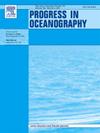Spatiotemporal variation in marine plankton communities driven by environmental changes in the East China sea
IF 3.6
3区 地球科学
Q1 OCEANOGRAPHY
引用次数: 0
Abstract
Unicellular plankton are the foundation of marine food webs and biogeochemical cycles. This study analyzed long-term observations (2009–2021) of the taxonomic composition and size structure of nano- to microplankton in the East China Sea to assess the impact of environmental changes on these communities. Over the past decade, aloricate ciliate and chain-forming diatom abundances have declined, likely due to rising sea surface temperatures and decreasing concentrations of phosphate, nitrate, and silicate. Sea surface concentrations of these nutrients and dinoflagellate biomass were positively correlated with the Pacific Decadal Oscillation (PDO) index, while the diatom-to-dinoflagellate ratio decreased as the PDO index increased. These findings reveal the large-scale climatic drivers of nutrient dynamics and plankton composition. The normalized biomass size spectrum (NBSS) slope was shallower in areas with higher salinities, diatom and ciliate biomasses, and diatom-to-dinoflagellate ratios, and it was steeper in areas with higher nutrient concentrations. The NBSS slopes were steeper (i.e. more smaller organisms) during winters with high nutrient concentrations, likely due to reduced light availability from high turbidity and increased grazing pressure. The 2017 summer cruise identified three spatial clusters of plankton communities that were influenced by different water masses. Cluster 1, influenced by the China Coastal Current, was dominated by athecate dinoflagellates. Clusters 2 and 3, influenced by the Taiwan Warm Current and Kuroshio Current, respectively, were dominated by diatoms. This study highlights the importance of long-term monitoring and comprehensive analyses to better understand how plankton communities will respond to climate change and anthropogenic activity.
环境变化驱动下东海海洋浮游生物群落的时空变化
单细胞浮游生物是海洋食物网和生物地球化学循环的基础。本研究分析了2009-2021年东海海域纳米至微型浮游生物的分类组成和大小结构,以评估环境变化对这些群落的影响。在过去的十年中,可能由于海洋表面温度上升和磷酸盐、硝酸盐和硅酸盐浓度下降,无钙纤毛虫和链状硅藻的丰度下降。这些营养物的海面浓度和甲藻生物量与太平洋年代际涛动(PDO)指数呈显著正相关,硅藻/甲藻比值随PDO指数的升高而减小。这些发现揭示了营养动态和浮游生物组成的大规模气候驱动因素。在盐度、硅藻和纤毛虫生物量以及硅藻/鞭毛比较高的地区,归一化生物量谱斜率较浅,而在营养物浓度较高的地区,归一化生物量谱斜率较陡。在营养物浓度高的冬季,NBSS的斜坡更陡峭(即更多的小生物),可能是由于高浊度和放牧压力增加导致的光可用性减少。2017年夏季巡航确定了受不同水团影响的三个浮游生物群落空间集群。第1群受中国沿海流影响,以甲藻为主。群集2和群集3分别受台湾暖流和黑潮的影响,以硅藻为主。这项研究强调了长期监测和综合分析的重要性,以便更好地了解浮游生物群落如何对气候变化和人类活动做出反应。
本文章由计算机程序翻译,如有差异,请以英文原文为准。
求助全文
约1分钟内获得全文
求助全文
来源期刊

Progress in Oceanography
地学-海洋学
CiteScore
7.20
自引率
4.90%
发文量
138
审稿时长
3 months
期刊介绍:
Progress in Oceanography publishes the longer, more comprehensive papers that most oceanographers feel are necessary, on occasion, to do justice to their work. Contributions are generally either a review of an aspect of oceanography or a treatise on an expanding oceanographic subject. The articles cover the entire spectrum of disciplines within the science of oceanography. Occasionally volumes are devoted to collections of papers and conference proceedings of exceptional interest. Essential reading for all oceanographers.
 求助内容:
求助内容: 应助结果提醒方式:
应助结果提醒方式:


